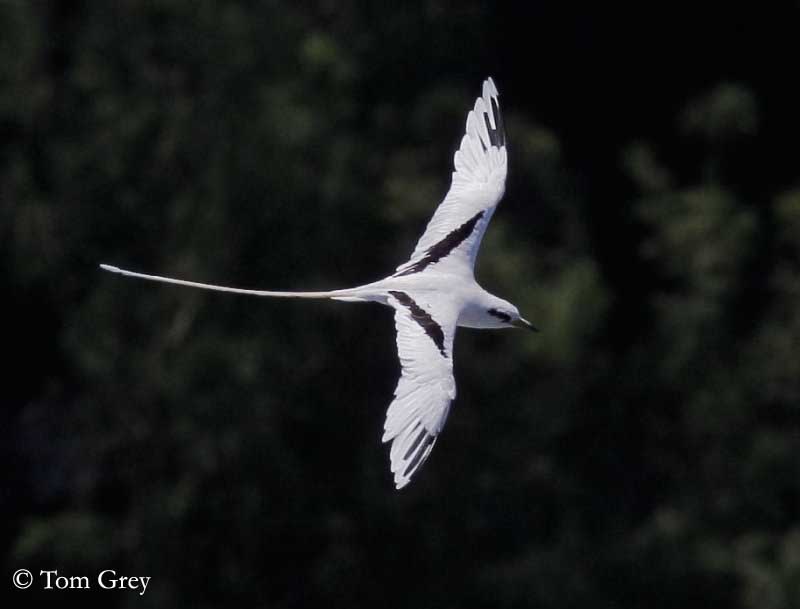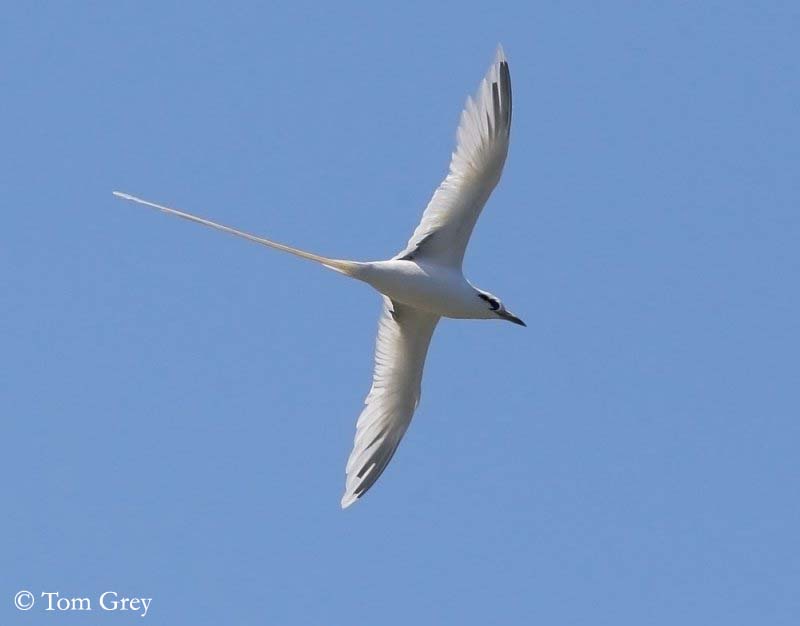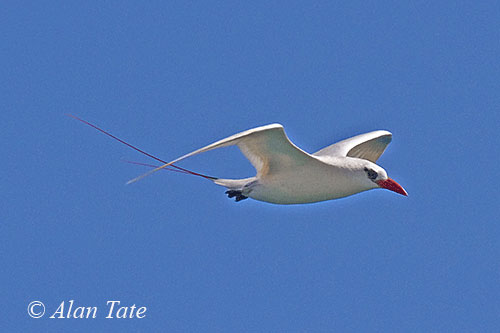
FAMILY PHAETHONTIDAE
Tropicbirds
The Tropicbirds are very elegant seabirds, living in the warm tropical and subtropical waters of the Pacific, Atlantic and Indian oceans, although the Red-tailed Tropicbird is not found in the Atlantic Ocean. They are largely pelagic, and breed on small oceanic islands with cliffs and rocky areas.
They were formerly grouped in the order Pelecaniformes, but following microscopic analysis of eggshell structure, some differences appeared and the Tropicbirds are now in their own order, the Phaethontiformes.
Actually, they are closer to the Sunbittern and the Kagu, both in the order Eurypygiformes, but also the pigeons and doves of family Columbidae, or the sandgrouses.
The three species have fan-shaped tail with long, white streamers, except the Red-tailed Tropicbird which has red streamers. They resemble large terns but are unrelated to. The two elongated central tail feathers play an important role during the aerial displays, moving side to side or floating in the wind. The Tropicbirds perform wonderful displays, with aerobatics in parallel, backwards flights, hovering and circling.
Photographers:
Roger Ahlman
Pbase Galleries Peru and Ecuador
Jean Michel Fenerole
Photos d’Oiseaux du monde
Tom Grey
Tom Grey's Bird Pictures
Patrick Ingremeau
TAMANDUA
Otto Plantema
Trips around the world
Alan & Ann Tate
AA Bird Photography
Text by Nicole Bouglouan
Sources:
HANDBOOK OF THE BIRDS OF THE WORLD vol 1 by Josep del Hoyo-Andrew Elliot-Jordi Sargatal - Lynx Edicions - ISBN: 8487334105
GOVERNMENT OF BERMUDA - Longtail Igloos
Animal Diversity Web (University of Michigan Museum of Zoology)
Bird Web (Seattle Audubon Society)
Fatbirder - The World’s Richest Information Resource about Birds for Birders
CREAGUS@Monterey Bay (Don Roberson)
Wikipedia, the free encyclopaedia

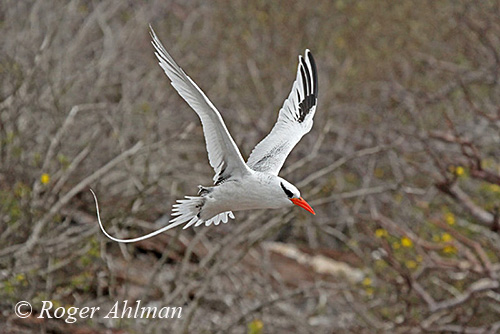
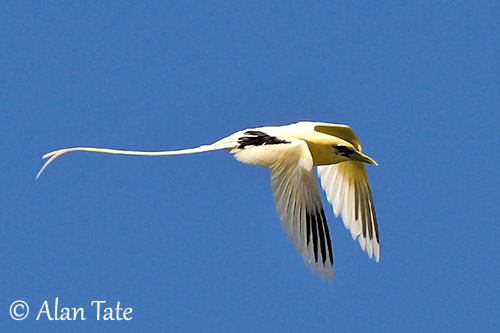
Subspecies Phaethon lepturus fulvus
Red-billed Tropicbird, Red-tailed Tropicbird and White-tailed Tropicbird have white plumage overall, with black marks on the upperwing, but the Red-billed Tropicbird shows black vermiculations on the upperparts.
On the white head, a conspicuous black eye-line is present in all species. The bill is stout and slightly decurved, varying from yellow to red depending on the species. The eyes are dark brown. The short, weak, whitish legs and the black webbed feet are located far back on the body, making them clumsy to the extreme while on the ground. They can only move on land by pushing themselves forwards with the feet.
The immatures lack the streamers and are very similar to large terns in non-breeding plumage.
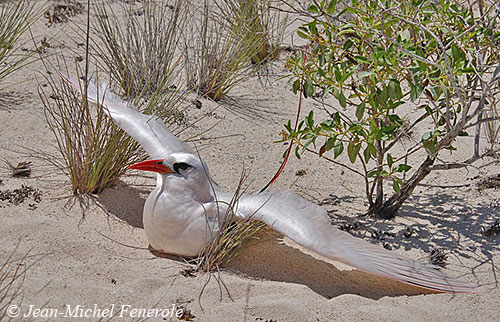
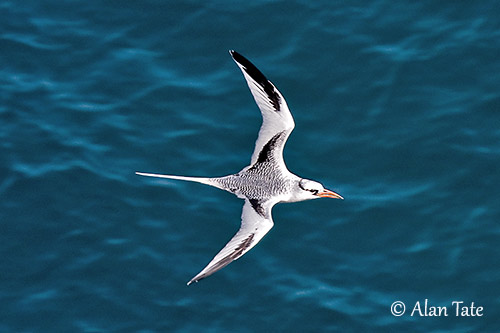
The Tropicbirds feed mainly on flying fish (Exocoetidae) caught in the air, but also squid (Ommastrephidae), other fish species and crustaceans. They forage mainly in the early morning and around dusk, when squid come near the surface where they are easier to catch.
Once a prey is detected while hovering, the tropicbirds catch their prey by plunge-diving from heights of up to 25 metres and more, like the Sulidae. The prey can be caught on, or very close to the surface, but also sometimes at a depth of several metres. It is held crossways in the bill.
The White-tailed Tropicbird tends to consume smaller prey than the other two species, probably due to the size of its bill.
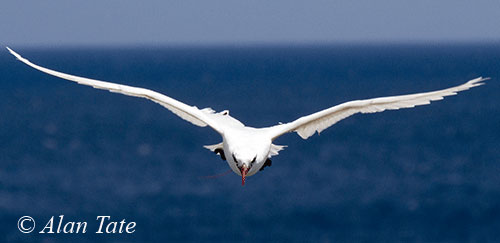
The Tropicbirds only come to land for breeding on remote oceanic islands where inaccessible areas provide them good nesting sites. They may nest on the forest floor, against the base of a large tree, but they also use inaccessible ledges, cracks, caves and rock crevices on cliffs. But they need areas where take-off and landing are relatively easy. They are colonial nesters.
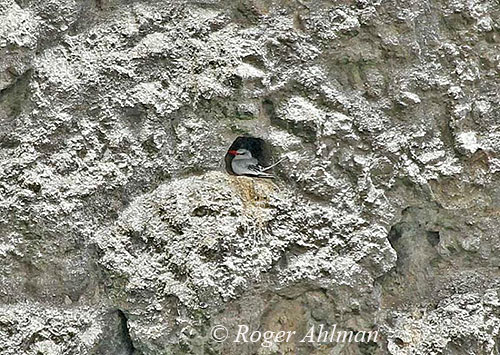
The White-tailed Tropicbird often nests in hollows and tree forks at some sites, both in Pacific and Indian Oceans.
The Red-tailed Tropicbird sometimes breeds on more open ground, often on the sand under the protection of some vegetation.
The Red-billed Tropicbird breeds in large holes and crevices, or under boulders on rocky offshore islands, in tropical and subtropical seas. It usually prefers inaccessible spot on cliff.
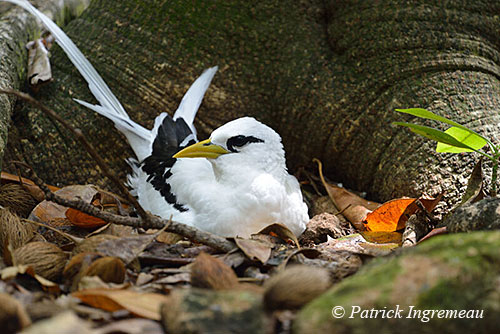
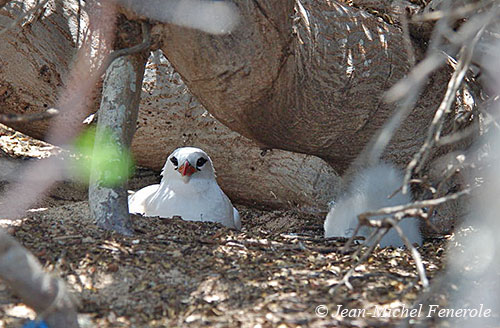
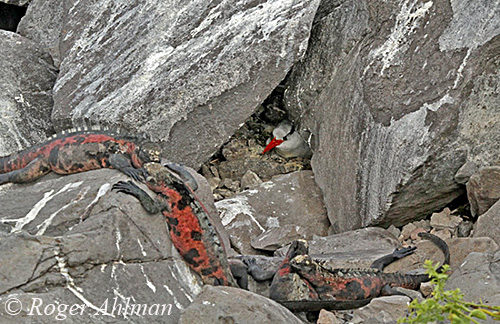
Outside of breeding season, they are highly pelagic. The Tropicbirds do not rest very often on the water, but when they do, they are buoyant, resting or swimming with the tail raised. At this period, they are wandering about and have to roost either on the water or possibly in mid-air.
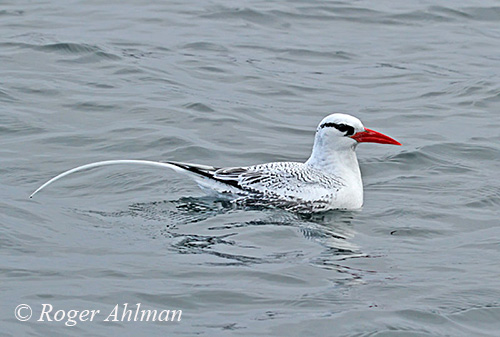
The tropicbirds have long, narrow, pointed wings, allowing them to perform a strong, direct flight. The wingbeats are rapid and powerful, recalling those of Columbidae. It less frequently glides or soars.
The take-off is sometimes difficult for all the three species, and for this reason, they need elevated spots to launch themselves into the air or to land at the nest-site.
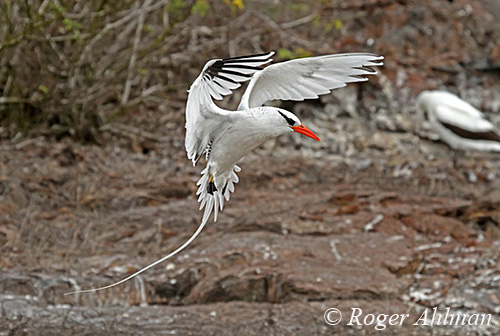
Landing
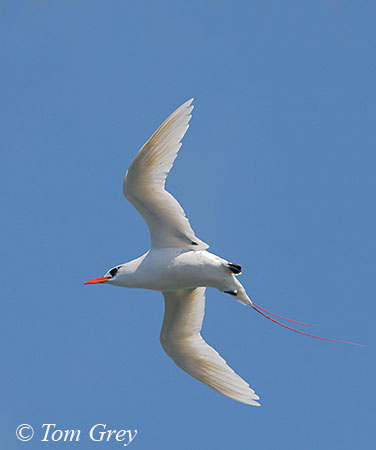
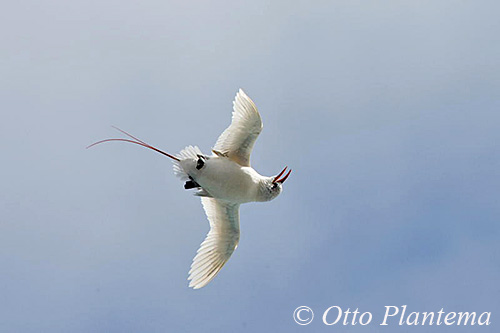
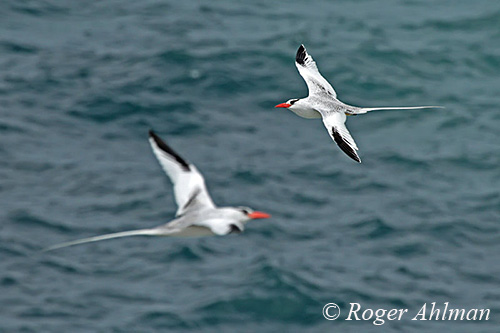
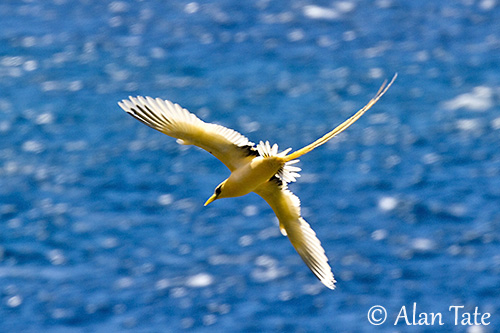
Subspecies Phaethon lepturus fulvus
But the beauty of these birds is really highlighted during the nuptial flights. The Tropicbirds perform very spectacular aerial displays accompanied by repetitive, loud, strident screams. They often display in small, tightly packed groups, flying and circling around in the vicinity of the breeding colonies. From time to time, a pair breaks away from the group and displays by performing aerobatics in unison, in a much synchronized sequence.
Both the White-tailed Tropicbird and the Red-billed Tropicbird fly in zig-zag, or perform long downwards glides, often descending several hundred metres while flying one above the other. The bird on top lowers its wings while the one below raises them, and the tips almost touch.
The Red-tailed Tropicbird has even more elaborate courtship flight during which the bird below glides along, while the other performs rapid wingbeats and hovers with almost vertical body. This display ends in an amazing back-pedalling effect while the bird is rising backwards, probably driven by the wind. During this display, the red streamers are lowered and shaken from side to side and the black feet are stretched out.
Following this sequence, the bird on top glides down and the roles are reversed, involving successive circles in the air.
While displaying over their future breeding sites, the birds search for potential nesting sites. The pairs already formed fly to the selected nest. Here, the copulation occurs without preceding ritual.
The Tropicbirds are monogamous with long-term pair bonds, and are colonial nesters. They start to breed at 2-4 years old. They tend to reuse the same nest in several following years because the sites are scarce.
Both adults build the nest usually placed on cliffs, on ledge or in rock crevice or on the ground, in a sheltered scrape.
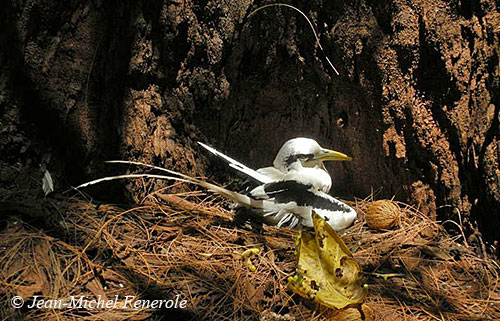
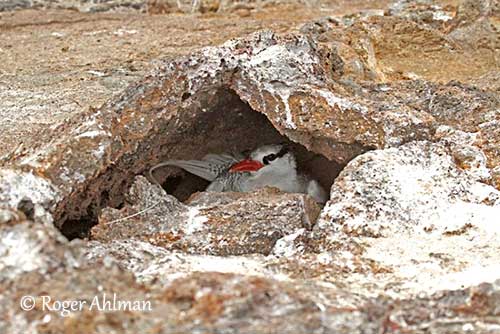
The female lays a single, oval egg of variable colour and markings. The incubation lasts 40-46 days. It is shared by both adults in stints of a few days, although in the Red-tailed Tropicbird, the stints may last up to 15-16 days.
At hatching, the chick is covered with dense, silky down which may be white, grey or fawn-grey. It is first permanently brooded by an adult, but then, after a few days, it is left alone at the nest.
At the beginning, it is fed by its parents with small quantities of semi-digested food regurgitated directly into its throat. The adult inserts the bill into the chick’s gullet. We can hear some soft “click” or “chuck” when the parents bring food to the nest. The chick may reply with gutturals chirps while begging for food.
As the chick is growing, it is fed on more solid prey while the frequency of feeds decreases. The young fledges about 12 to 13 weeks after hatching, and performs some post-breeding dispersal.
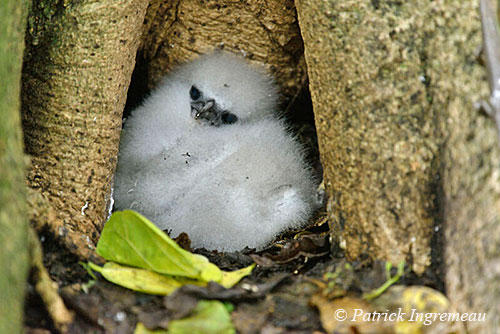
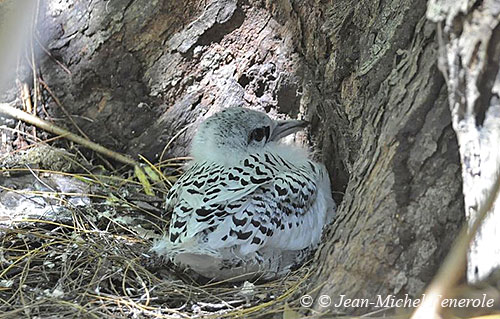
When they are disturbed at the nest, the adults hiss or screech.
In some parts of the range, the breeding success may be affected by lack of nest-site availability. The Tropicbirds strongly defend the nest and fights can be violent. The sharp, pointed bill of these birds can cause injuries on head and neck.
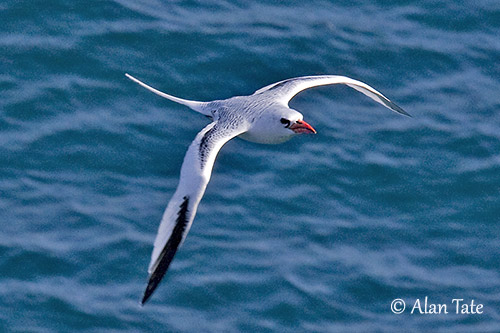
Following the breeding season, both adults and young leave the colonies and the islands and wander far from land. At this period, they lead a totally pelagic life. While flying over the sea, they produce sharp, piercing whistles.
The moult of the adults occurs before the return to the breeding sites. The young birds stay away for several years before returning as adults themselves.
The Tropicbirds do not perform true migrations but they may move depending on the weather. They are sometimes carried far out of their usual areas by storms, and occasionally even a long way inland where they usually die.
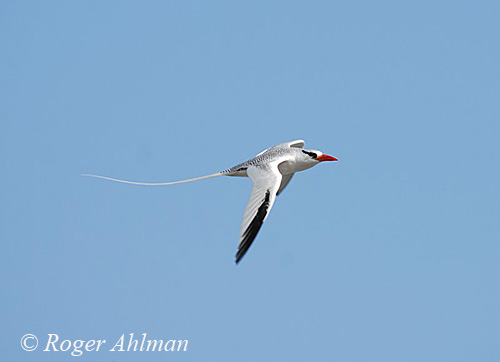
The feathers of the Tropicbirds, especially the streamers, have been traditionally used for ornamental purposes, but the birds were generally captured but not killed. In ancient times, egg-collecting and killing of chicks and adults for human consumption have been frequent.
The main threats include human exploitation, habitat destruction, and predator introductions into breeding areas. The cats attack the Tropicbirds even in the nesting cliffs. The Polynesian Rat (Rattus exulans) causes losses of eggs and chicks of the Red-tailed Tropicbird and also preys upon adult White-tailed Tropicbird. The eggs of the latter species are eaten by the Black rat (Rattus rattus), but the Brown rat (Rattus norvegicus) appears more devastating in its effects than the two others. Road construction and housing development also have a negative impact when made on the breeding sites.
Hurricanes, oil pollution at sea are frequents threats for these species.
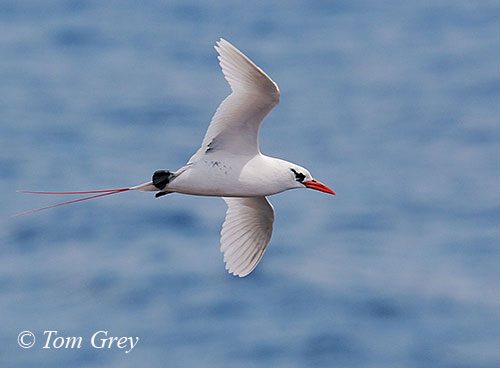
However, artificial nesting sites, named “Longtail Igloos” have been created in many areas of the Bermuda coast, involving better breeding success.
The oil pollution is decreasing thanks to new regulations concerning dumping oil at sea.
There are now predator-free islands due to eradication of introduced mammal predators.
At this moment, these three species are not globally threatened and evaluated as Least Concern.
